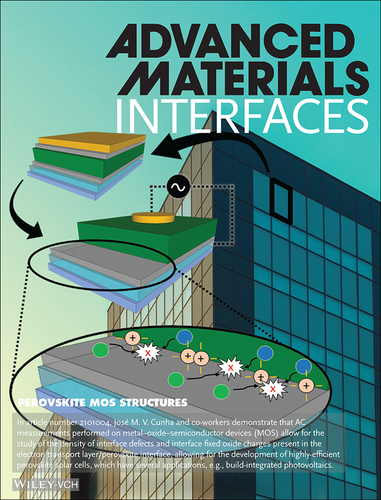Nanofabrication for Optoelectronic Applications research group paper selected as “frontispiece”
A paper published by the Nanofabrication for Optoelectronic Applications (NOA) research group was selected for a “frontispiece” in the Advanced Materials Interfaces journal, name named “Perovskite Metal–Oxide–Semiconductor Structures for Interface Characterization”
The Advanced Materials Interfaces is an internationally recognized journal of the well known “Advanced Materials” family from Wiley. While the Journal is recent, it is already in the first quartile (Q1) of the Scimago Journal & Country Rank in the areas of Mechanical Engineering and Mechanics of Materials (Scimago Journal & Country Rank), while in the Journal Citation Reports it is Q1 in Multidisciplinary Chemistry. In fact, the journal is in the top 7% of journals in the Mechanical Engineering area.
The authors of the paper demonstrated the usefulness of tailored electrical measurements that were inspired from the micro/nanoelectronics area in the development of perovskite solar cells, which is one of the most promising photovoltaic technologies.
MSc José Miguel Cunha, the first author of the study and PhD Student doing his research at INL, stated that “The full understanding of all layers that make up the solar cell is still in the early stages, despite the increased research interest in perovskites. Thus, the innovative method presented in the paper is of pivotal importance for the improvement and optimization of efficient charge transport layers used in the perovskite technology”.
Professor Pedro Salomé, group leader of NOA research group, recognizes “The importance of the perovskite technology for the future of photovoltaics” and he adds that “The development of efficient charge transport layers is of utmost importance for perovskite solar cells to achieve higher technology readiness level (TRL), which remains critical for its successful integration in the energy market”.
Moreover, Doctor Alexandra Barreiros, senior scientist of the Portuguese Laboratory for Energy and Geology (LNEG) states "the novel use of optoelectronic devices such as Metal-Oxide-Semiconductors - as the one demonstrated in this paper - for the study of materials in interfaces of perovskite solar cells is a game-changer since it creates a novel way of understanding these complex structures".
The study was partnered with researchers from Universidade de Aveiro, Portugal; Universidade de Coimbra, Portugal; Portuguese Laboratory for Energy and Geology (LNEG), Portugal; ISEP, Portugal; Universidade Nova de Lisboa, Portugal; imec, Belgium and UCLouvain, Belgium. This work was supported by several FCT individual grants and projects NovaCell, InovSolarCells, SuPerSolar and Baterias 2030.

